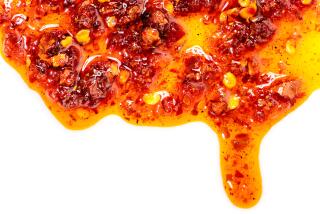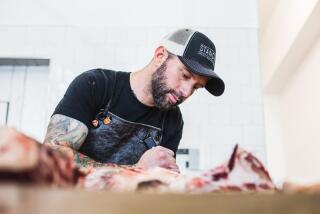Substitute-meat makers’ art imitates life
Ethan Brown held up one of his ready-to-eat vegetarian chicken strips and peeled off stringy strands that mimicked the moist meat of the real thing.
“That’s the beauty. That’s absolutely everything,” said Brown, founder of Beyond Meat, admiring the filaments of faux chicken at a cafe near the company’s El Segundo headquarters.
The company gets close to creating that authentic but elusive texture by blasting soy and pea proteins through an alternating cascade of high heat and high pressure in a stainless steel machine.
The result is mock meat that replicates the genuine product enough to make people forget the tastes of springy tofu turkey, MSG-laden veggie burgers and plasticky facon — fake bacon, for the uninitiated.
So convincing is Brown’s imitation poultry that it has attracted investment from tech giants such as Microsoft Corp.’s Bill Gates, Twitter Inc. co-founders Biz Stone and Evan Williams and venture capital firm Kleiner Perkins Caufield & Byers. Whole Foods Market helped refine the product before rolling it out at its stores last year.
“I thought they were just another boutique business selling overpriced products to well-heeled vegetarians at Whole Foods. But I was blown away when they came to meet me,” Stone said.
“They pitched really big thinking,” he said. “They said they weren’t just going after the meat market; they wanted to be meat. They said their competitors are the people who make chicken.”
Brown, who started out in the energy industry, sees mock meat not only as a much healthier alternative but also as a way to reduce methane and other harmful gases emitted by animals and to ease a meat shortage predicted to occur by midcentury.
Beyond Meat and other makers of such substitutes are chasing increasingly discerning palates by cooking up grub that captures more of the bite and appearance of animal flesh.
Match Meats of St. Louis, for instance, offers a line of vegan ground meat substitutes. Field Roast of Seattle takes inspiration from traditional charcuterie to offer vegan products such as Wild Rice Cranberry Fig Roast En Croute and White Truffle Country Pate.
All are fighting for a piece of the meat-alternatives market, which has grown 8% from 2010 through last year to $553 million, according to research firm Mintel.
Janet Corvin, 52, has been a vegetarian since she was a child but still desires the taste and texture — the mouth feel — of meat. She turns to the fake stuff at least six times a week. Vegetables alone just won’t do.
“It’s got a flavor and texture we all learn to like,” Corvin said recently as she stood in front of the mock-meat section at a Whole Foods in Glendale. “It’s salty, it’s greasy. We all crave grease.”
Brown doesn’t expect everyone to be like Corvin. But he hopes enough people switch from animal protein to a plant-based version to make a difference in the long run.
“Things like [real] fried chicken taste great,” he said. “So why give it up? Just don’t have it every day.”
The effort to improve mock meat comes as studies warn that real meat may not be a sustainable source of protein.
The United Nations’ Food and Agriculture Organization projects global meat consumption will rise 73% by 2050, putting massive strains on the world’s water and grain supplies.
“Put simply, there’s no way to produce enough meat for 9 billion people,” the expected global population then, Gates wrote in a blog post titled “The Future of Food.” “Yet we can’t ask everyone to become vegetarians. We need more options for producing meat without depleting our resources.”
Google Inc. co-founder Sergey Brin is one of the scientific and financial heavyweights looking for a solution. He spent $325,000 to fund a laboratory-grown hamburger developed by a Dutch scientist that was unveiled earlier this year.
Beyond Meat and others are betting on a shift in consumer attitudes. Protein is so prized in these low-carb times that it’s perfectly normal to see it marketed in forms other than meat — even a Baby Ruth candy bar.
But this hasn’t necessarily led to hordes of Americans giving up pork chops and bacon-wrapped hot dogs.
A Gallup poll last year placed the percentage of vegetarians in the U.S. at 5%, down slightly from 6% in 1999. The meat industry doesn’t expect that to change in the near future.
“While I know there are some amazing food scientists out there who can achieve great results, it’s hard for me to imagine that tofu or tempeh will compete with T-bones any time soon among people who enjoy the beefy taste and texture of a steak,” said Janet Riley, a spokeswoman for the American Meat Institute.
Brown, 42, agrees that his biggest challenge is re-creating that experience.
He grew up visiting a dairy farm that his father, then an environmental policy professor at the University of Maryland, ran as a hobby. He came to believe that the farm’s 100 Holstein cows should be treated just as lovingly as the family dogs. He started cutting back on meat at 13 and has been a vegan the last 12 years.
Having worked in the Maryland and Washington, D.C., offices of Ballard Power Systems, a Canadian energy company, he became engrossed in the link between industrialized livestock and climate change.
In 2006, the United Nations estimated that the livestock industry produced 18% of the world’s emissions each year — more than cars, trains and planes combined. And in 2009, former World Bank environmental advisor Robert Goodland placed the industry’s share of annual global emissions at 51%, saying the U.N. had underestimated methane and other pollutants.
Such studies prompted Brown to invest in vegan restaurants in the Washington area in 2006. The menu featured sandwiches stuffed with wheat gluten patties and Chinese popcorn “chicken” smothered in brown sauce. He expected customers in Birkenstocks and hemp pullovers. Instead he got doctors, lobbyists and lawyers.
Despite growing demand, he didn’t think any of the food was good enough to eat without heavy seasoning or sauce.
“We had to mask all this stuff,” Brown said. “With our Philly cheese steak, the main event was not the steak. But what if it was? What if you had a true replication?”
Brown ordered every kind of mock meat he could find, looking for a breakthrough. None of it passed muster.
Then he came across a research paper written by Fu-hung Hsieh and Harold Huff at the University of Missouri, an institution that prides itself on its agricultural programs, particularly meat.
Hsieh and Huff spent years seeking the holy grail of imitation meat: an indistinguishable fake. The team developed a technique that broke down soy proteins by alternating high temperatures with high pressure. The trick was finding the right combination of the two.
Pressed through a large, stainless steel extruder, the manipulated proteins ooze out like pale Play-Doh. Constant tinkering brings the sludge closer to the mouth feel of real chicken.
Brown was impressed. He struck a licensing agreement in 2010 to use the technology.
“Man’s had a lot of time to screw around with meat and fire,” said Brown, who believes his product is about 80% of the way toward perfection. “We have more advanced technology at our disposal, but it’s still going to take a while.”
The company sells 12-ounce trays of its fake-chicken strips for $5.29 at Whole Foods. The strips are vegan and free of gluten and genetically modified organisms. They’re also kosher.
Stores will soon be offering Beyond Meat’s new line of imitation cooked ground beef. The company also is exploring chicken nuggets and ersatz drumsticks.
“We’re not trying to get people to eat kale and quinoa,” Brown said. “We’re just trying to get your kids and my kids to have a healthier chicken nugget.”







